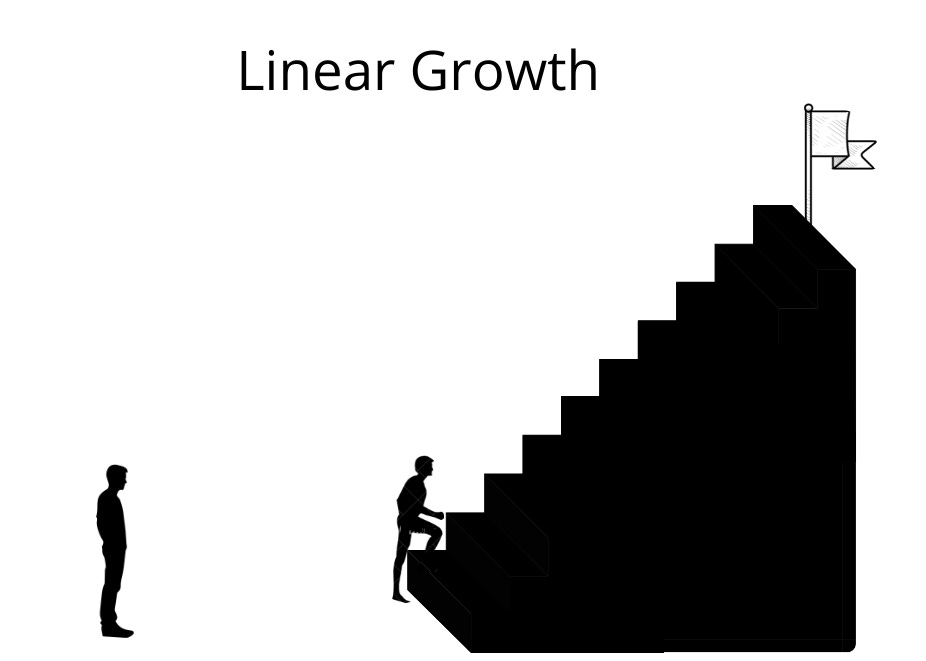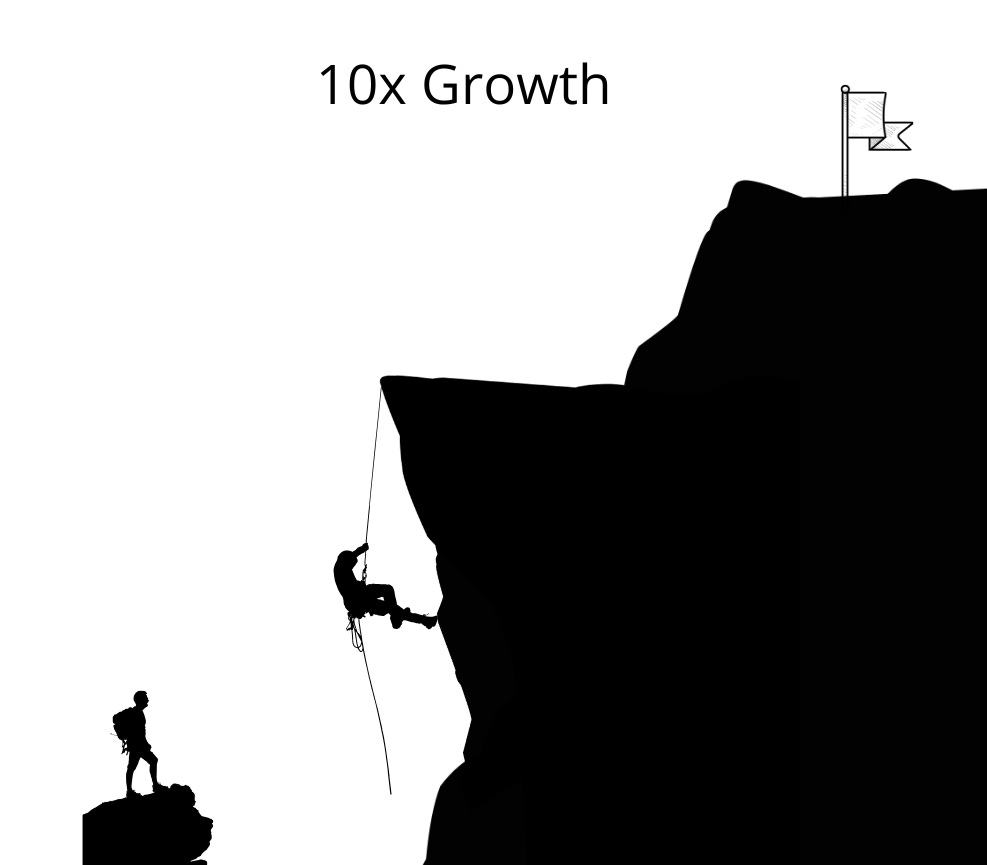Thinking in Orders of Magnitude: A Transformative Approach to Personal and Professional Growth
Summary: Essentially, thinking in orders of magnitude involves setting 10x higher goals, thereby challenging the conventional linear mindset, which would impose more humble and proximate goals. This form of logarithmic goal setting fosters creative problem-solving, ambitious goal setting, rapid personal and professional growth, resilience, and a long-term perspective. This mindset is crucial to keep up with the fast pace of change and growth that our current world demands. 10x improvements require new approaches and ways of thinking to achieve such a goal. If the right approach is adopted, it is my hypothesis that more ambitious goals can be reached in the same timeframe compared to smaller goals in the old thought paradigm.
Introduction
People often think about progress in a linear way, a ladder-like progression towards your ultimate goals. You reach one milestone of a certain magnitude, and the next one you set tends to be double the size. For example, you would reach a net worth of a million dollars and then think about how to make your next million.
But what if the next milestone was 10 times as big?
In this article, I plead that after making one million, you should start thinking how to make the next 9 million. The concept of thinking in orders of magnitude, or logarithmic thinking, stands as a radical yet profoundly powerful approach. This method challenges individuals to envision and strive for exponential growth, scaling ambitions not by linear steps, but by multiples of ten.
It's a mindset shift from asking "How can I improve by 10%, or 2x?" to "How can I become 10 times better?"
Such a perspective is not just about setting higher goals; it's about fundamentally reimagining the scope and scale of what's possible. To illustrate, consider two entrepreneurs. The first, adhering to a linear mindset, aims to increase her business revenue by a steady 10% each year. The second, embracing logarithmic thinking, sets a far more ambitious goal: to increase revenue tenfold. While the first stays within the realm of the predictable and manageable, the second propels her vision into a realm of transformative possibilities.
Another way to think about it is Peter Thiel’s famous strategy for setting goals. In his book Zero to One, he invites us to think about how to reach 10-year goals in 6 months. This is another example of ‘thinking in orders of magnitude’, where timelines for the future are crunched and sped up.
In this article, I want to expand the idea of thinking in orders of magnitude, and show you how you can use it in your everyday life to grow and improve.
The Rare Practice of Exponential Thinking
Despite its potential, few people adopt exponential thinking. This rarity stems partly from our natural inclination towards a linear perception of growth and change.
Linear thinking, being straightforward and predictable, aligns with our everyday experiences and education.
In linear thinking, the concept of 1+1 equals 2 and 1+2 equals 3 is easy to grasp and apply. We measure progress in incremental steps, setting goals that build on previous achievements in a gradual and predictable manner.
In contrast, exponential thinking demands a cognitive leap - it requires envisioning growth in exponential terms, which can seem daunting and unrealistic at first.
Here, the notion of 1+1 isn't simply equal to 2; instead, in exponential terms, it represents a 10-fold increase (10 x 10), written as 102, which is 10. Similarly, a threefold increase signifies a is expressed as 103 which is 1000. This way of thinking necessitates reimagining the potential of each step taken and exponentially increasing the scale of our ambitions.
For those who embrace this mindset, the results can be eye-opening and mind-expanding. It pushes individuals to think creatively, to challenge existing limitations, and to redefine what they consider achievable.
With my companies, 10x thinking is a fundamental practice in every aspect of our work. Whether in decision-making, in how we manage companies, or even in how each team member should see their own progress.
The trick is to master speedy execution while holding the highest standards of performance. Through acting fast while incorporating feedback and repivoting where necessary, we achieve 10x growth.
But this is only made possible by adopting the right mindset first: moving away from linear growth towards 10x thinking.
Five Advantages of Thinking in Orders of Magnitude
1. Creative Problem-Solving: Linear thinking often leads to conventional solutions. In contrast, aiming for 10x improvement necessitates innovative, out-of-the-box thinking. It drives individuals to reconsider fundamental assumptions and explore novel approaches.
2. Enhances Goal Setting and Ambition: Setting goals in orders of magnitude elevates ambition. It shifts the focus from minor improvements to transformative changes, encouraging bolder visions and more significant achievements.
3. Accelerates Personal and Professional Growth: Exponential goals lead to exponential growth. This mindset propels individuals to learn and adapt rapidly, fostering a steep learning curve and rapid skill acquisition.
4. Encourages Risk-Taking and Resilience: Pursuing lofty goals inevitably involves higher risks. However, it also builds resilience. Each setback becomes a learning opportunity, contributing to a more robust, agile approach to challenges.
5. Cultivates a Long-term Perspective: Logarithmic thinking requires a long-term vision. It encourages planning for future scalability and sustainability, rather than settling for short-term gains.
Impact of Exponential Thinking
The power of thinking in orders of magnitude lies in its ability to fundamentally transform perspectives and outcomes.
By setting exponentially higher goals, individuals and organizations can achieve breakthroughs that would be inconceivable under a linear mindset. It's about redefining the art of the possible, pushing boundaries, and daring to envision a radically different future.
This transformative impact can be seen in various examples.
10x thinking can be applied to revenue growth.
Suppose you founded a startup and you had 1m in revenue last year. When making plans for the future, you shouldn't think ‘how can I double my revenue next year?’ but instead you should think ‘how can I grow my revenue by 10x in one year?’.
Doubling every year is linear thinking. But increasing by one order of magnitude requires new ways of thinking.
This type of thinking usually starts with the following question: how can we make this service 10x cheaper from a first principles perspective?
Take Uber. They started off from taxi services and attempted to figure out how to reduce prices significantly. In order to keep this drop in prices, autonomous cars coupled with on-demand ride-hailing would lead to an exponential drop.
There’s a difference between visionary thinking and 10x thinking. Visionary thinking sets a bold, long-term goal that inspires innovation. 10x thinking, on the other hand, focuses on exponentially improving an existing process or service, driving innovation by rethinking how things are done to achieve massive, transformative results. While both are ambitious, 10x thinking emphasizes immediate, actionable steps toward achieving exponential growth.
This also highlights that thinking in orders of magnitude helps with creativity. Instead of thinking about how to improve something in a linear way, you can think about ways to transform things from the bottom up, creating exponential improvements.
Think about 10x thinking applied to engineering.
A paradigmatic example is when people were trying to figure out how to get faster horses, but instead the car was invented.
For example, a battery storage company can ask ‘how can we make it 10x more efficient?’. This question is necessary if the company wants to have traction in the market. This always requires new ways of thinking about engineering inventions.
Another example would be the creation and commercialization of hypersonic planes. These would be able to fly from London to New York in under 1 hour (so 8x faster than normal planes). Hermeus is currently developing aircraft that can travel from New York to London in 90 minutes, and they’re a great example of 10x thinking in engineering.
Similarly, in personal development, this mindset encourages individuals to revolutionize their skills, careers, and lives, by compounding experience and self-knowledge.
For instance, I started working at a very early age, with the goal of garnering as many skills and experiences as possible and trying to understand myself and my place in the world.
By aiming to learn and grow a little bit every day, I have gained clarity about the meaning of life and how to live better.
This approach allowed me to build my own path according to my values and beliefs.
Recently, I founded Utopia Capital, an impact fund investing in companies that are addressing the world's toughest challenges.
This journey exemplifies how the daily pursuit of growth and learning, compounded over time, can lead to profound personal development and impactful ventures.
A Neat Takeaway and Outlook
The key takeaway from exponential thinking is the realization that the limits we often perceive are more psychological than real.
By challenging ourselves to think in orders of magnitude, we unlock a new realm of possibilities.
This mindset is not just about achieving higher numbers; it's about cultivating a transformative approach to life and work, fostering innovation, and pursuing a vision that transcends conventional boundaries.
As we look to the future, the importance of this mindset becomes even more apparent.
In an ever-evolving world, where change often happens exponentially, the ability to think in orders of magnitude will be crucial for personal and professional success.
It's a mindset that aligns with the pace of technological advancement and the rapid transformation of industries and societies.
Remember this: 10x thinking requires changing your mindset every time you reach a new level. Instead of setting a goal and gradually building the steps towards it, 10x thinking requires constantly raising the bar, forcing yourself to improve at every single milestone, setting higher goals, and holding yourself to the highest standards.
The concept of thinking in orders of magnitude isn't just relevant to business—it's a game-changer for personal development as well.
The same mindset that helps build exponential wealth can be applied to personal goals and growth. By setting milestones in terms of 10x improvements—whether it’s in fitness, skills, or productivity—you push yourself beyond small, incremental steps and instead pursue transformative growth.
This approach mirrors the 10x Wealth Principle, where each milestone multiplies the next goal. The 10x wealth principle is a concrete example of thinking in orders of magnitude
Personal development is another aspect where thinking in orders of magnitude can help drive growth. Like wealth creation, personal growth thrives when thinking in continuous exponential terms, pushing the limits of what you think is possible, and never settling for the linear path.
By aligning your personal goals with a 10x mindset, you not only achieve rapid progress but also open up new opportunities for success in every aspect of life.
Conclusion
In conclusion, thinking in orders of magnitude is a powerful and groundbreaking concept. Its rarity only underscores its potential to bring about transformative change.
By challenging the linear norms and daring to envision exponential growth, individuals and organizations can achieve unprecedented levels of success and innovation.
This mindset is not just about setting higher goals; it's about reimagining the scope of what's possible. It encourages creative problem-solving, ambitious goal setting, rapid growth, risk-taking, resilience, and a long-term perspective.





